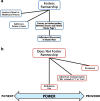"We'll do this together": the role of the first person plural in fostering partnership in patient-physician relationships
- PMID: 20033624
- PMCID: PMC2839333
- DOI: 10.1007/s11606-009-1178-3
"We'll do this together": the role of the first person plural in fostering partnership in patient-physician relationships
Abstract
Background: Partnership is integral to therapeutic relationships, yet few studies have examined partnership-fostering communication behaviors in the clinic setting. We conducted this study to better understand how statements in which physicians use the first person plural might foster partnership between patient and provider.
Methods: We audio-recorded encounters between 45 HIV providers and 418 patients in the Enhancing Communication and HIV Outcomes (ECHO) Study. We used the Roter Interaction Analysis System (RIAS) to code for statements made by the physician that used the first person plural to refer to themselves and their patient. Using multiple logistic regression, we examined the associations between the occurrence of one or more first person plural statements with patient ratings of provider communication. To better understand the meaning of first person plural statements, we conducted a qualitative analysis.
Main results: Providers were mostly white (69%) and Asian (24%); 57% were female. Patients were black (60%), white (25%), and Hispanic (15%); 33% were female. One or more first person plural statements occurred in 92/418 (22%) of encounters. In adjusted analyses, encounters with first person plural statements were associated with younger patient age (OR 0.97, 95% CI 0.94-0.99), higher patient depression scores (highest tertile compared to lowest tertile: OR 1.89, 95% CI 1.01-3.51), the patient not being on anti-retroviral therapy (OR 0.53, 95% CI 0.29-0.93), and older provider age (OR 1.05, 95% CI 1.00-1.09). After adjustment, patients were less likely to highly rate their provider's communication style if first person plural statements were used (AOR 0.57, 95% CI 0.33-0.96). There were 167 first person plural statements made by physicians in the 418 encounters. Qualitative analysis revealed that many first person plural features had at least one negative feature such as being overtly persuasive ("That's going to be our goal"), indirect ("What can we do to improve your diet?"), or ambiguous ("Let's see what we can do"), although there were also positive statements that involved patients in the health-care process, contributed to a mutual understanding, and addressed the patients' goals.
Conclusions: Contrary to our hypotheses, use of first person plural was not associated with higher ratings of provider communication, probably because some of these statements were overtly persuasive, indirect, or ambiguous. Physicians should become aware of benefits and pitfalls of using the first person plural with patients. Further research is needed to determine the most effective methods through which providers can build alliances with patients.
Figures


References
-
- Price R. A Whole New Life: An Illness and a Healing. New York: Scribner; 1982.
-
- Roter DL. Roter Interaction Analysis Manual. Johns Hopkins University Bloomberg School of Public Health; 1999.
Publication types
MeSH terms
Grants and funding
LinkOut - more resources
Full Text Sources
Medical

